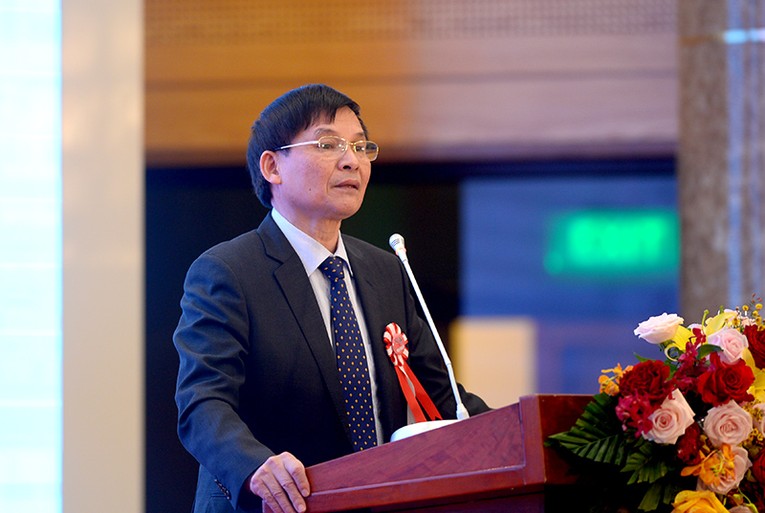Speaking at the seminar "Promoting the circular economy of the textile industry" held on the morning of August 26, Vice President and General Secretary of the Vietnam Textile and Apparel Association (Vitas) Truong Van Cam said that the textile industry does not only ranked in the top export turnover with 40.4 billion USD in 2021, accounting for 12% of the total export turnover of the country, but is still a large trade surplus of Vietnam, with 16.2 billion USD in 2021 and 11 years. billion USD 7 months of 2022.
Shifting focus to sustainable development
According to Mr. Cam, the period of focusing on the fast development orientation of Vietnam's textile and garment industry has ended, from this period onward until 2030, the industry will gradually shift its focus to sustainable development, circular business. .
Then, from 2030 to 2045, develop effectively and sustainably according to the circular economy model. Complete the domestic value chain and join a high-value position in the global supply chain. Export and domestic consumption by own brands of regional and international stature.
In the draft "Strategy to develop Vietnam's textile, garment and footwear industry to 2030, with a vision to 2035", it is expected that the average export turnover will increase by 5% - 6%/year in the period to 2020. 2030 (estimated in 2030 is 68-70 billion USD); increase from 2-3%/year in the period from 2031 to 2045 (about 95-100 billion USD in 2045).
Vietnam's textile and garment industry has very early access to the circular economy model. Since 2017, the industry has established a Committee for Sustainable Development on Environment and Labor, in collaboration with many organizations around the world to implement.

Mr. Truong Van Cam - Vice President and General Secretary of Vietnam Textile and Apparel Association
The Vietnam Textile and Apparel Association has launched a PPP model for sustainable development, in which the prerequisite is that enterprises must be profitable; ensure jobs for employees and have a harmonious labor relationship; less waste, reuse water, recycle products
Circular economy is an inevitable trend
In addition to the sustainable development model, Vitas leaders also shared that the complete economic model for the textile industry is also facing many problems, in which, the supply of mainly imported raw materials is limited. The localization rate of the industry is currently only 30-35%.
In addition, there is currently no spatial planning for the development of large industrial parks with centralized wastewater treatment. Many localities still follow the old perception and are not interested in licensing weaving and dyeing projects. The cost of sustainable development has increased, so many businesses, especially small and medium enterprises, have not been determined or have not enough resources, which is also a big challenge. However, there are many factors that promote and force Vietnam's textile and garment industry to implement a circular economy.
The government has made strong commitments to reduce net emissions, and the industry's large export market has set a specific roadmap and target on using recycled products. Specifically, Europe with the new Strategy "Sustainable Textiles" that can be applied from 2023 includes 3 standards: durability, reusability, fiber-to-fiber recycling and mandatory recycling content; enterprises must print data related to standards and production processes on clothing labels; prohibits the company from disposing of unsold clothing or from reporting the amount of disposal.
Agreeing with the comments of the leaders of the Textile and Apparel Association, the representative of the German Development Cooperation Organization also said that the European Council has approved the Strategy on Sustainable Textiles. Accordingly, there are 16 new laws and policy solutions that will be applied to make textile products entering the European market more durable and reusable.
The representative of the German Development Cooperation Organization emphasized that the circular economy cannot be realized by working alone and can only be successful with the companionship, sharing and responsibility of the State, businesses and sectors. civil organization. Especially the sharing of responsibility between the factory and the distributor.
According to Vitas Vice President Truong Van Cam, in order for businesses to successfully build a circular economy model, it is first necessary to raise awareness about circular business; thoroughly understand the challenges and opportunities when innovating business operations to a circular model; take appropriate steps to focus on strong points, such as: water circulation, roof voltage... In particular, it is necessary to calculate the benefits - costs, and the conversion route accordingly.
Enterprises also need to gather documents related to traceability of raw materials and accessories, meeting the requirements of recycling rate, product life cycle, clean materials, high recyclability; coordinate with brands to fulfill the market's requirements of green, sustainable, eco-design...; cooperate with enterprises in the industry and in industrial parks to collect wastewater and waste for treatment and reuse...
THU TRANG